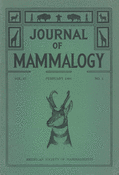-
Views
-
Cite
Cite
J. B. Siebenaler, David K. Caldwell, Cooperation among Adult Dolphins, Journal of Mammalogy, Volume 37, Issue 1, February 1956, Pages 126–128, https://doi.org/10.2307/1375558
Close - Share Icon Share
Extract
A number of instances of apparent solicitude on the part of adult dolphins for their young, either alive or dead, have been reported in the recent literature. These have particularly related to the mother's habit of holding her young at the surface in an apparent effort to aid it in breathing. Instances of such solicitude in captivity have been reported for the Atlantic bottlenose dolphin, Tursiops truncatus, by McBride (Nat. Hist., 45: 29, 1940), McBride and Hebb (Jour. Comp. & Physiol. Psych., 41: 115, 1948), and McBride and Kritz-ler (Jour. Mamm., 32: 254, 1951). Examples of this phenomenon in nature have been given by Moore (Amer. Midi. Nat., 49: 136, 1953) for T. truncatus, and by Hubbs (Jour. Mamm., 34: 498, 1953) for the Pacific bottlenose dolphin, T. gilli.
As far as we can discover, there has been only one other instance reported in which an adult made an apparently definite effort to protect another adult that was injured. This behavior was described by Hubbs (loc. cit.) where he reports a case in which a striped dolphin, Lagenorhynchus obliquidens, stayed close by a harpooned companion “frequently forcing its way between the dying beast and the ship and pushing it away.” Two related instances, perhaps showing an even higher level of intelligence, have recently been observed during collecting operations for the new Gulfarium, The Living Sea, at Fort Walton Beach, Florida.





